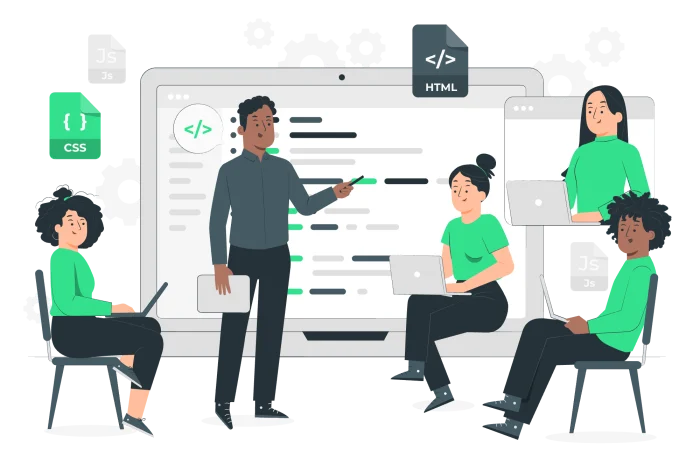
A solid online presence is essential for both organizations and individuals in today’s increasingly digital environment. Websites serve as a digital shop that facilitates engagement, exchange of ideas, and business dealings. A well-developed website improves navigation, establishes trust, and improves user experience. It is an effective tool for information sharing, marketing, and creating an online persona. The vast and ever-changing collection of websites that we use on a daily basis would not exist on the internet without web development.
Related: Top 10 Trusted Web Development Companies In Bangalore

an online digital world that consists of linked websites with multimedia content that offers services or information.
An Internet Protocol address is a unique identification for communication that is assigned as a numerical label to devices connected to a computer network. Tools like What is my IP address help users identify this label for troubleshooting or configuration purposes.
The Hypertext Transfer Protocol Secure (HTTPS), serves as the basis for data transfer on the World Wide Web, enabling web servers and browsers to share information more easily.
The process of writing instructions (code) for computers to execute, enabling them to perform specific tasks or functions.
The user-facing side of website development, deals directly with users, with an emphasis on producing the interactive aspects and visual components.
The server-side aspect of developing a website, manages databases, server logic, and data flow and is invisible to users but essential to the operation of the website.
A content management system is a piece of software that makes it easier for non-technical people to create, edit, and manage digital information, including websites.
The process of preventing illegal access, attacks, and damage to computer systems, networks, and data while guaranteeing the secrecy and integrity of digital information.

What it does: It creates the visual and interactive parts of a website that users see.
Example: Designing buttons, forms, and menus to make a website look good and work smoothly.
What it does: It manages the behind-the-scenes aspects of a website, ensuring data flows seamlessly.
Example: Handling server logic and databases to make sure the website functions as intended.
What it does: It handles both the visible parts of a website (front-end) and the behind-the-scenes work (back-end).
Example: Developing and maintaining the entire website, from its appearance to its functionality.
What it does: It encompasses the entire process of creating and maintaining websites.
Example: Designing, developing, and updating websites to meet user needs and business goals.
What it does: It builds applications that run on desktop computers, like software for Windows or macOS.
Example: Creating a word processing or photo editing application for your computer.
What it does: It designs and builds applications for mobile devices such as smartphones and tablets.
Example: Developing a mobile app for shopping or social media.
What it does: It creates interactive and entertaining games for various platforms.
Example: Developing a video game for consoles, PCs, or mobile devices.
What it does: It develops software for embedded systems found in appliances, cars, or industrial machinery.
Example: Programming the software for a smart thermostat or a car’s navigation system.
What it does: It focuses on making software secure and protecting against unauthorized access and cyber threats.
Example: Implementing measures to safeguard user data and prevent hacking attempts.
In front-end development, the user interface and user experience are created. The following are the main languages used in front-end development:
Together, these languages produce an engaging and interactive user interface.

Back-end development focuses on server-side logic, database management, and ensuring the smooth functioning of the website. Common back-end languages include:
Choosing the right back-end language depends on factors like project requirements, scalability, and personal preferences.

The foundation of the website is laid at this phase by specifying the characteristics it should have, determining the target audience, and describing the website’s purpose. This first step establishes the project’s course and guarantees that the website meets its objectives and effectively serves its target audience.
Wireframes and the website’s visual blueprint are created during the design phase. These graphic components act as a roadmap for creating an interesting and intuitive layout. Design factors guarantee a user-friendly and visually appealing experience by taking into account both the site’s overall structure and appearance.
After the design is complete, the visual concept is turned into a working website via the development step. The application of coding languages and frameworks makes this possible. The development stage transforms the static design into a dynamic and functioning digital entity by introducing interactivity, functionality, and responsiveness.
Extensive testing is carried out to find and fix any flaws and guarantee the seamless operation of the website. This stage includes essential components such as feature validation and compatibility testing across multiple devices. Thorough testing ensures a satisfying user experience by resolving any possible problems before the website is made available to the general audience.
This signifies the website’s official public launch. At this point, users can access the website online because it is hosted on a server. By doing this, the project moves from development to accessibility and lets users interact with the website and take advantage of its features.
Updating and maintaining the website’s functionality is the responsibility of the maintenance phase. Important activities include updating content on a regular basis, responding to new issues, and adjusting to requirements that change. By providing ongoing maintenance, the website is guaranteed to meet the changing needs of its visitors while staying safe, up-to-date, and functional.
The process of making a website is like casting a spell – planning, designing, developing, testing, deploying, and maintaining. Now armed with magical languages for both front-end and back-end, go create websites that amaze and connect in the enchanting internet world. May your coding be smooth, your designs be magical, and your websites truly enchanting!
This site is protected by reCAPTCHA and the Google Privacy Policy and Terms of Service apply.